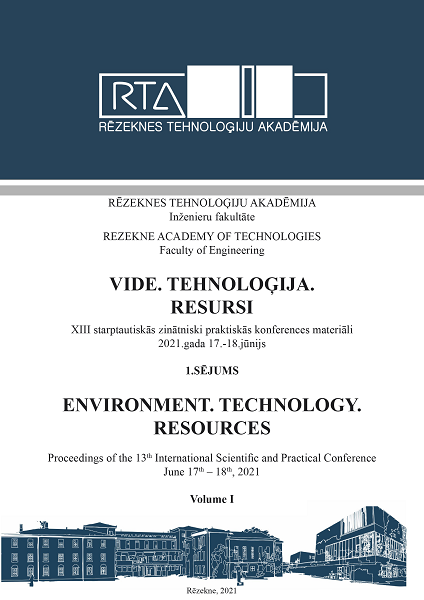THE METHODOLOGY FOR THE CREATION OF AN ADAPTED MODEL FOR THE TRANSITION TO THE CIRCULAR ECONOMY FOR THE SMALL AND MEDIUM ENTERPRISES OF LATVIA IN A LONG TERM PERSPECTIVE
DOI:
https://doi.org/10.17770/etr2021vol1.6518Keywords:
circular economy, eco-innovations, industrial production, quality standardsAbstract
Research will focus on investments for the development of the company. Transition to the circular economy is understood in many cases only as an unnecessary obstacle, not as the new business model. Production based on the linear model "take, make, dispose of" is not possible anymore based on decreased environmental quality. Increased production efficiency could help promote the company's prestige, gain tax allowances, create optimistic co-operation with the state, municipality, and maintain sustainability in terms of the balance achieved between economic, environmental and social interests. Although the research until now is in an early stage, the research purpose is to create an adapted model for the implementation of the circular economy for the small and medium enterprises (from now on – SMEs) of Latvia in a long-term perspective. Research will focus on the following qualitative data analysis methods – SWOT, factor, economic contribution, structured interviews at expert level, overall structured interview in the form of the questionnaire. From quantitative methods, hierarchical cluster or partial cluster method will be used in this research, analysing 3966 organisations in the Eco-Management and audit scheme (from now on – EMAS) at the European level that ensure compliance with the essential environmental requirements under EMAS Regulation No.1221/2009 . Until now within the research, the number of EMAS organisations have been selected between 29 different countries (total number of observations) in 5 sectors (energy, water, waste management, food industry, port terminals), allowing to make the cross-country comparison and describe the involvement level of EMAS in each country. Before using the cluster method, it is essential to assess the cluster trend and whether the cluster method is suitable for research data. The next step will involve using a hierarchical cluster or partial cluster method (a certain number of clusters will be created). It is necessary to use different techniques to evaluate and interpret the created cluster results in future work. Until now, the main conclusion from the literature study is that Latvia has no organisation registered under EMAS and the term "circular economy" is a prevalent trend nowadays worldwide, which can be justified with 114 different terms of the circular economy. Expected results will be the following – issued new criteria for SMEs, issued the adapted model and issued recommendations and suggestions for developing the eco-innovation market.
Downloads
References
Access to European Union Law, "Regulation (EC) No 1221/2009 of the European Parliament and of the Council of November 25, 2009, on the voluntary participation by organisations in a Community eco-management and audit scheme (EMAS), repealing Regulation (EC) No 761/2001 and Commission Decisions 2001/681/EC and 2006/193/EC", EUR-Lex-32009R1221-EN, 2009. [Online]. Available: EUR-Lex - 32009R1221 - EN - EUR-Lex (europa.eu). [Accessed: March. 14, 2021].
Access to State Environmental Bureau. [Online]. Available: Vides pārraudzības Valsts birojs - EMAS - Reģistrs (vpvb.gov.lv). [Accessed: March. 14, 2021].
Access to European Commission EMAS Register. [Online]. Available: Emas register (europa.eu). [Accessed: March. 14, 2021].
J. Potting, M. Hekkert, E. Worrell. "Circular Economy: Measuring Innovation in the product chain" PBL Netherlands Environmental Assessment Agency, Hague, Netherlands, Policy Rep. p.9, 2017. [Online]. Available: https://www.pbl.nl/sites/default/files/downloads/pbl-2016-circular-economy-measuring-innovation-in-product-chains-2544.pdf. [Accessed: March. 14, 2021].
Access to Lursoft databases of enterprises. [Online]. Available: Lursoft - databases of enterprises. [Accessed: March. 14, 2021].
Access to Enterprise Register. [Online]. Available: https://www.ur.gov.lv/en/register/. [Accessed: March. 14, 2021].
Access to the Latvian policy planning document database [Online]. Available: Rīcības plāns pārejai uz aprites ekonomiku 2020.–2027.gadam | POLSIS (mk.gov.lv). [Accessed: March. 14, 2021].
P. Watson, J. Wilson, D. Thilmany, S. Winter, "Determining Economic Contributions and Impacts: What is the difference and why do we care?" The Journal of Regional Analysis&Policy, vol. 37(2), pp. 1-15, 2007. [Online]. Available: https://www.ntc.blm.gov/krc/uploads/74/Watson,%20et%20al%20Impacts%20vs%20Contribution%2037-2-6.pdf. [Accessed: March. 14, 2021].
A. Kassambara, "Practical Guide to Cluster Analysis in R," Multivariate analysis, vol.1, p.14-15, 2017. [E-book]. Available: STHDA, https://www.datanovia.com/en/wp-content/uploads/dn-tutorials/book-preview/clustering_en_preview.pdf [Accessed March 14, 2021].
M. Garbade, "Home page - Dr., Michael J.Garbade", September 2018. [Online]. Available: Understanding K-means Clustering in Machine Learning | by Dr. Michael J. Garbade | Towards Data Science [Accessed March 14, 2021].
J. Winter, D. Dodou, "Five-Point Likert Items: t-test versus Mann-Whitney-Wilcoxon (Addendum added October 2012)," Practical Assessment, Research, and Evaluation: Vol. 15, 2010, Article 11. DOI: https://doi.org/10.7275/bj1p-ts64 Available: https://scholarworks.umass.edu/pare/vol15/iss1/11 [Accessed March 14, 2021].
J. L. Ruiz-Real, J. Uribe-Toril, J. P. Valenciano, J. C. Gázquez-Abad, "Worldwide Research on Circular Economy and Environment: A Bibliometric Analysis," Int J Environ Res Public Health, 2018 November 29;15(12):2699 2018. DOI: 10.3390/ijerph15122699 Available: https://pubmed.ncbi.nlm.nih.gov/30501129/ [Accessed March 14, 2021].
J. Laffont, J. Tirole, "Pollution permits and environmental innovation", Journal of Public Economics, 1996, Volume 62, Issues 1–2, Pages 127-140, https://doi.org/10.1016/0047-2727(96)01576-9 Available: http://www.sciencedirect.com/science/article/pii/0047272796015769 [Accessed March 14, 2021].


